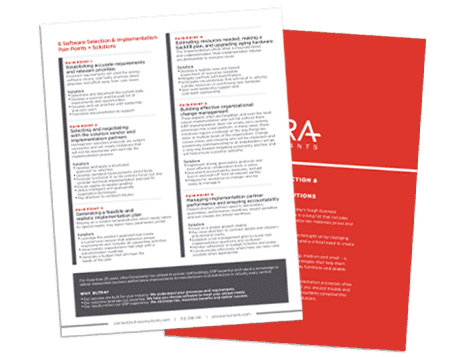Today’s ERP systems for Consumer Products Manufacturers (CPG) must drive true transformation.
In order to compete, consumer goods companies must keep pace with customer demand while managing margins and complying with ever-changing safety and environmental regulations.
Companies must also manage a variety of pressures ranging from the price of raw materials needed to produce their goods, to the energy needed to run their manufacturing plants.
Speedy product development and replenishment lifecycles are the order of the day since today’s consumer goods manufacturers are faced with growing demands for the fast delivery of personalized goods. information systems should help optimize supply chains and help manufacturers that are facing tightening margins.
To compete and thrive, it’s critical to understand key criteria about ERP systems for Consumer Products Manufacturers. ERP systems can provide many benefits to CPG manufacturers. Here are 5 guidelines for evaluating CPG ERP solutions.
Guidelines for Selecting a CPG ERP System
As an independent ERP consultant team, we speak with many companies looking to better handle the functional areas they need to run and grow their business.
Some of the key areas project teams are challenged with involved areas such as managing demand planning and forecasting; integrating customer orders via EDI, and streamlining warehouse management to name just a few.
In general, to drive business process improvement, Ultra reminds CPG firms to keep in mind the following guidelines:
- Process automation: Look for features and functions of an ERP system that takes out reliance on manual intervention and siloed spreadsheets, so the team is better positioned to deliver new products quickly and more cost-efficiently
- Full Integration with CRM: Be sure the ERP system provides a seamless connection to CRM features for optimal customer service, helping to manage order customization, promotions, trade spending, and rebates. It’s key to easily manage customer relationships and sales orders.
- Integrated Product Configuration: CPG companies are expected to provide quality and accuracy to customers. Enterprise systems should offer product configuration basics, and be integrated to configure and customize products based on unique needs, so it’s easy to make modifications, track costs, and maximize performance.
- Compliance Functionality: Keep an eye out for the latest features to help comply with product safety standards. Today’s modern systems help organizations meet increasingly complex customer and regulatory mandates related to reporting, labels and other areas.
- Streamlined EDI: Be sure systems can better streamline seasonal forecasts, Electronic Data Interchange (EDI), distribution, and optimizing workflow.
While not an exhaustive list, this is a good look at what to keep in mind when evaluating ERP systems for Consumer Products Manufacturers.
A Real-World Example
As an example of the power of evaluating and selecting ERP systems for Consumer Products Manufacturers, our team recently worked with a $250 million consumer products company that produces hardware for the home renovation industry. The US company sells into Home Depot and Lowes and deals with EDI Big Box requirements. The manufacturer also provides a full product portfolio of decorative cabinet hardware, functional hardware, home accessories as well as wardrobe hooks via e-commerce channels.
In this “omnichannel” environment, the CPG company looked to Ultra to select and implement enterprise technology to help reduce costs, increase quality, introduce new products, and improve efficiency while driving supply chain performance.
We went into the business process analysis phase assessing the current state of how well the company’s existing software provided real-time visibility into inventory, current production, schedules, and demand.
A thorough business process review uncovered many gaps in systems and processes, especially in the areas of demand forecasting, product configuration, EDI, PLM and Design Management, and Supply Chain Management.
After this analysis, Ultra led the CPG team through Enterprise Software Selection that led to an implementation of a system that drove the desired current state processes. The team reduced risk, had confidence the technology initiative would generate ROI, and worked with Ultra during implementation project management.
6 SOFTWARE SELECTION & IMPLEMENTATION PAIN POINTS + SOLUTIONS
Software selection and implementation processes often present challenges of their own. To steer you around trouble and help you drive success, Ultra’s experts compiled a list of pain points and solutions to be aware of as you embark on this journey.

Table of Contents
More ERP material...
AI in Food and Beverage Manufacturing
Discover how AI is revolutionizing food and beverage manufacturing, enhancing quality, reducing…
How ERP for Quality Control Eliminates Manual Documentation Chaos
This post will examine why managing quality records outside of an ERP…
Assessing Your AI Maturity
This article breaks down how businesses can measure their AI maturity to…



